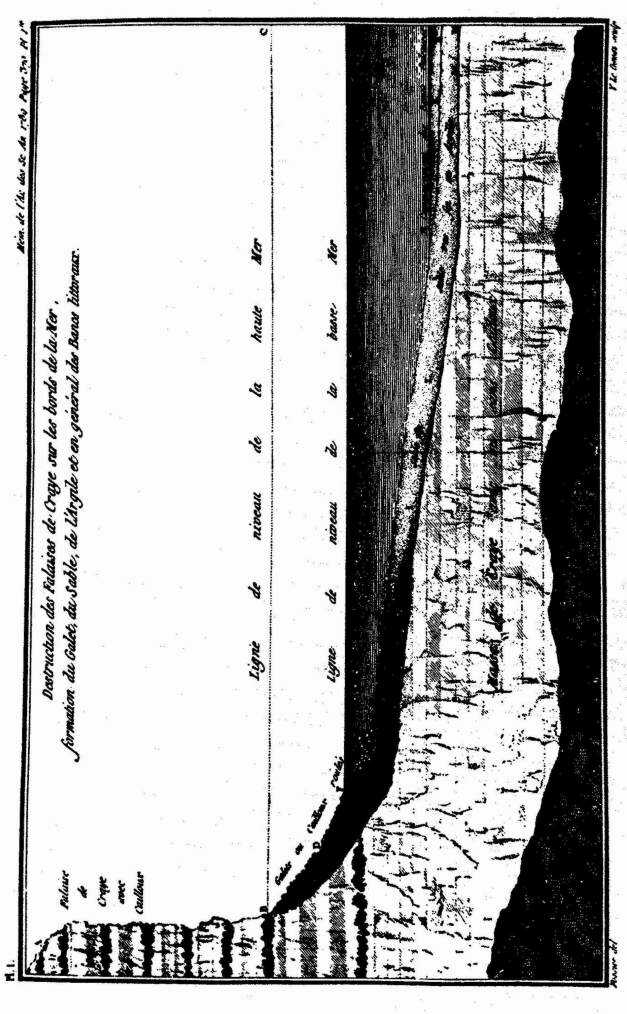|
|
A Source Book in Geology [1400-1900]
Contents:
Show Summary
Hide Summary
Biographical SummaryAntoine Laurent Lavoisier, French chemist, largely responsible for the modern concept of the elements, worked with Guettard on the geologic map of France.
Geology
Lavoisier
LITTORAL AND PELAGIC BEDS
1789
Translated from Mémoires de l’ Académie des sciences, 1789, pp. 351–371, 1793.
A part of the materials which are present at the surface in the lower parts of the earth and as far down as it is permitted us to penetrate are placed in horizontal beds. There one finds immense masses of marine bodies of all species, so that it cannot be doubted that, in very distant time, the sea covered a great part of the earth that is now inhabited.
But if this first glance is followed by a more profound examination of the arrangement of the beds and the materials that compose them, one is astonished to see all that is characteristic of order, uniformity, and tranquillity as well as all that marks disorder and movement.
———————
These first reflections lead us to a natural conclusion, which is that there should exist in the mineral kingdom two very distinct types of beds, one formed in open sea at great depth, which, following the example of M. Rouelle, I shall call pelagic beds; the others formed along the coast, which I shall call littoral beds. These two types of beds ought to have distinctive characters which would not permit confusion. The first should present masses of calcareous material, debris of animals, shells, and marine bodies accumulated slowly and peacefully through an immense sequence of years and centuries. The other, on the contrary, should present throughout the mark of movement, destruction, and tumult.
. . . The beds formed in the open sea, or pelagic, should be and are in fact composed of nearly pure calcareous matter, that is to say, simply the material of the shells accumulated without mixture. The beds formed at the coast, the littoral beds, on the contrary, can
 FIG. 9.—Diagram accompanying Lavoisier’s study of littoral deposits, 1793. FIG. 9.—Diagram accompanying Lavoisier’s study of littoral deposits, 1793.
be composed of materials of an infinity of types, depending on the nature of the coasts. . . .
But that which might escape the first glance—although it would be realized after minutes of reflection—is that the materials of which the littoral beds are formed ought not to be indiscriminately mixed. On the contrary, they should be arranged and disposed in accordance with certain laws. The movement of the waters of the sea, decreasing steadily from the surface to the bottom, at least to a depth of forty to fifty feet, ought to carry on a definite washing process analogous to that in the treatment of ores, along the edges of the sea. This should even increase in extent as the steepness of the slope decreases. The coarsest materials, like the cobbles, should occupy the highest part and mark the limit of high tide. Lower, the coarse sands, which are nothing but attenuated pebbles, should range themselves. Below, in the parts where the sea is less tumultuous and the movements less violent, the fine sands should be deposited. Finally, the lightest materials, the most finely divided, like clay or silicious earth in a pulverized state, should remain suspended for a long time. These materials ought to be deposited only at a rather great distance from the coast and at such a depth that the movement of the sea is almost nil.
Without entering the calculations which the most learned analysis would necessitate, it is seen in general that the curve of the bottom, from the coast to open sea, should fairly approximate a segment of parabola, the axis of which would be parallel to the horizon. That is to say, the inclination of the coast to the horizon at the limit of the open sea should approach forty-five degrees. Thereafter it should go, diminishing, to the place where the water of the sea is in absolute repose, and from there its base should tend to become absolutely horizontal.
The first plate is intended to give an idea of what thus takes place at the edges of the sea, in localities where the coast is chalk. It is that which one observes in upper Normandy and on the corresponding coasts of England.
Contents:
Chicago: Antoine Laurent Lavoisier, "Littoral and Pelagic Beds," A Source Book in Geology [1400-1900] in A Source Book in Geology [1400-1900], ed. Kirtley F. Mather and Shirley L. Mason (New York: Hafner Publishing Company, 1939), 126–128. Original Sources, accessed May 4, 2024, http://www.originalsources.com/Document.aspx?DocID=249H77E6NXUHEEN.
MLA: Lavoisier, Antoine Laurent. "Littoral and Pelagic Beds." A Source Book in Geology [1400-1900], in A Source Book in Geology [1400-1900], edited by Kirtley F. Mather and Shirley L. Mason, New York, Hafner Publishing Company, 1939, pp. 126–128. Original Sources. 4 May. 2024. http://www.originalsources.com/Document.aspx?DocID=249H77E6NXUHEEN.
Harvard: Lavoisier, AL, 'Littoral and Pelagic Beds' in A Source Book in Geology [1400-1900]. cited in 1939, A Source Book in Geology [1400-1900], ed. , Hafner Publishing Company, New York, pp.126–128. Original Sources, retrieved 4 May 2024, from http://www.originalsources.com/Document.aspx?DocID=249H77E6NXUHEEN.
|